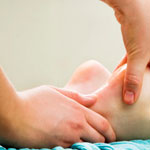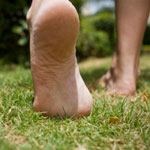Flat feet
Podiatrists usually do not use this term which is very often a laypersons description of a foot that is usually excessively pronated at the sub talar joint. A quick inspection of this type of foot will reveal a foot that has a low arch (or no arch) and a heel that turns outwards. The toes may be shown to be clawing and a possible bunion developing / developed. The heel(s) of this persons shoes may often be worn down and the inside of the shoe showing signs of bowing in. The patient with this type of foot often seeks the advice of a podiatrist because they are concerned about a number of the following;
- They notice their feet do not look quite right.
- Their feet may ache alot, (especially in the arches) ,most often after exercise and this aching can sometimes extend to their legs and knees especially at the end of the day or even in bed at night when they can sometimes complain of hot or tired feet, cramp feelings or a need to put their feet outside the duvet.
- They may have noticed a bunion developing.
- Their new shoes do not last long before they have to be replaced.
- They notice that they are prone to recurring / frequent sports injuries.
Please note that many people with flat feet have no symptoms and therefore may only be offered advice and no treatment. It should also be noted that children frequently exhibit flat feet (as they have not yet developed any muscle tone in their early years) but in severe cases may be advised to wear custom made insoles (orthotics).
Patients who suffer a range of neurological conditions such as Cerebral Palsy, Muscular dystrophy and Spina Bifida will frequently be found to have feet that are increasingly flat with age.
Treatment
A biomechanical examination of the patient will often reassure the individual or very often in a severe case, result in a prescription for a pair of insoles or orthotics. Such a course of action will very often result in a significant reduction or eradication of the symptoms (e.g. reduction in aching calf muscles, painful knees, tired feet etc) of the patient and should be seen by the patient as a type of preventative treatment. By wearing orthotics, in the long term, one would often expect the patient with biomechanical problems to be less exposed to the likes of arthritic wear and tear damage in articulating surfaces of joints (like the knee). This should ensure a better quality of mobility in our advancing years.
For further information on flat feet or other conditions and services please call 01227 360940 / 01795 430020 / 07985014566 or send us an email info@hernebaychiropody.co.uk

These are synonomous to warts, except that they tend not to protrude beyond the level of the surrounding soft tissue.

This condition can generally fall into two categories; an involuted nail and an acute in growing toe nail.

A quick inspection of this foot will reveal a foot that has a low arch (or no arch) and a heel that turns outwards.

Our Services
Conditions Treated
- Plantar Fasciitis
- Verrucae
- All nail conditions (in growing, thick, fungal etc.)
- Diabetes
- Flat feet
- Plantar Fasciitis
- Verruca
- All nail conditions (in growing, thick, fungal etc.)
- Diabetes
- Flat feet
- Corns
- Callous (Hard skin)
- Bunions
- Hammer toes
- Blisters
- Bursae
- Rheumatoid arthritis
- Osteoarthritis
- Chilblains
- Mortons Neuroma
- Soft corns
- Cracked skin
- Circulatory diseases
- Achilles tendonitis
- Pronation
- Supination
- Tired / aching feet
- Foot strain
- Metatarsagia
Area we cover
Herne Bay Whitstable Canterbury Sturry - Blean Faversham - Westgate - Tankerton - Medway towns

